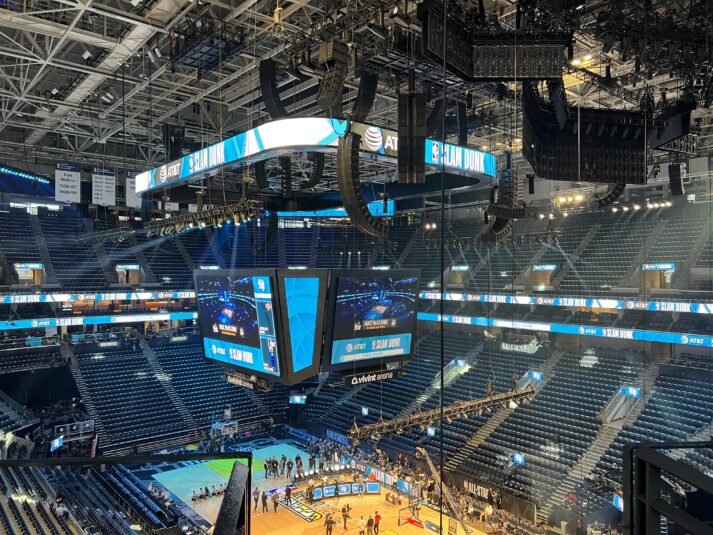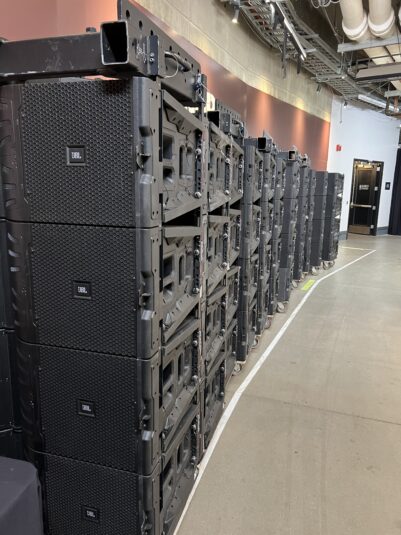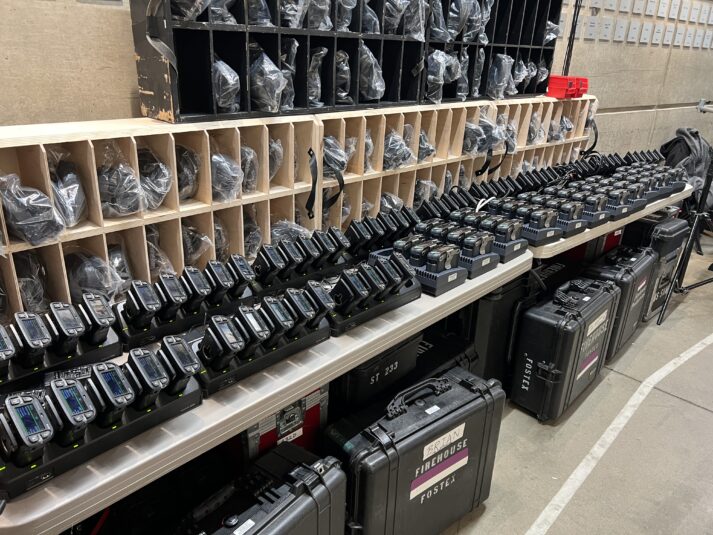Live From NBA All-Star 2023: Firehouse Productions, WBD Sports Streamline Audio Infrastructure for Weekend Events
Growing connection of entertainment and sports produces signal-flow changes
Story Highlights
The recent Super Bowl Halftime Show was hailed as the third-most-watched television show in history, with an estimated 118 million people tuning in to see Rihanna — 5+ million more viewers than the game itself attracted. But that annual event has become just the highest peak in a mountain range of entertainment that has been partnering with major sports events.
At the NBA All-Star Game at Salt Lake City’s Vivint Arena this weekend, global superstar Post Malone will perform a medley of hits following the first-ever in-arena NBA All-Star Draft, part of a weekend’s worth of entertainment and sports events that will also include Grammy Award-winning singer, songwriter, and record producer Burna Boy, 2023 Grammy Award winner and Oscar-nominated singer/producer Tems, and rapper Rema, who will collectively headline an Afrobeats-themed NBA All-Star Game Halftime Show.
The list of broadcast entertainment and sports combinations has only grown in recent years, as has the complexity of putting on both types of productions in the same place at the same time.
‘It Was Becoming a Mess’
“[The event] had turned into 22 different shows, television and radio stations, and games, all with their microphones and cabling and consoles. It was becoming a mess,” says Mark Dittmar, VP, Firehouse Productions, which produces the live-event side of NBA and other major-league events and also fabricated the NBA’s COVID “bubble” in Orlando in 2020 and 2021. “Dave [Grundtvig, senior audio supervisor, remote operations, Warner Brothers Discovery Sports] and I set out to fix that a few years ago and have continued to improve on it.”

JBL V25 boxes will be configured in 11 line arrays of various lengths to cover Vivint Arena seating areas and court, a design intended to keep speech intelligibility high and overall volume low.
At Vivint Arena, Dittmar notes, there are 170 users on the Riedel Artist intercom system alone, with more on a separate system in the broadcast compound. Hundreds of microphones and other transducers will be deployed.
Corralling the Complexity
To manage that complexity, Firehouse (which is also managing the event’s RF) and WBD Sports collaborated to consolidate as much of the event’s signal path as possible: for instance, setting up various key elements, such as crowd microphones, as shared resources and sending them as splits to any broadcast participants that want to use them. They are also creating two separate 5.1 mixes — one of the games and other sports events, the other of the entertainment performances — and making them available as MADI streams to the broadcast stakeholders. They’ve also set up two separate teams responsible for managing all that audio in both the arena and the broadcast compound, so any issues in either domain can be addressed without having to cross that threshold.

Firehouse Productions shipped 116 boxes of components of a PA system to Las Vegas for NBA All-Star Weekend in Salt Lake City.
“We’re not providing every microphone; some companies will still deploy some of their own,” for such purposes as studio shows and courtside reporters, says Dittmar. “But we’re covering a good chunk of the microphones used, and anyone who needs that audio can just grab it from us. It has drastically reduced clutter in the building and the compound, such as cabling, and that helps reduce the potential for problems to develop.”
Live Sound
For the house, Firehouse Productions is also deploying what Dittmar describes as “a very large” PA system, comprising 116 JBL V25 boxes configured in 11 line arrays of various lengths covering the seating areas and the court. The longest arrays will have 16 boxes each, the length intended to tightly focus the sound without the need for more amplification. The strategy is to keep speech intelligibility high while staying within what Dittmar describes as the NBA’s “very strict” venue decibel limits: 88 dBA, with an LEQ (equivalent continuous sound level, or the total sound energy over time) of 30.
“The reason is that [the NBA wants] the entertainment and the game to be at about the same levels,” he explains. “They don’t want fans hearing a huge disparity between music and basketball, to make it feel as though they were competing with each other for attention. The point of the PA-system design is control of the sound: directivity and intelligibility. On a PA system like this, where the sound doesn’t go is as important as where it does.”
There’s Money in Entertainment
The increasing intersection between sports and entertainment, especially live music with high-profile stars, is proving lucrative for broadcasters and leagues. The NHL All-Star Game has sold out its broadcast-advertising inventory, Ad Week reports, with 23 new advertisers signing on for this year’s events.
Developing more-organized audio source and signal-path management is critical to keeping the workflow controlled as sports and music continue to intertwine, Dittmar says: “There’s a lot going on there and more and more companies that have a piece of it. We’re figuring out better ways to manage that.”

